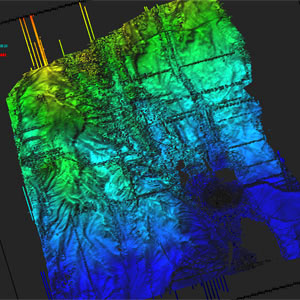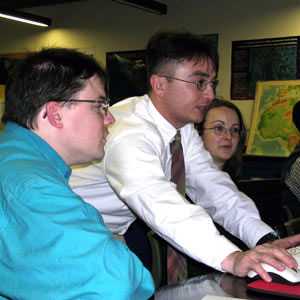 |
| An image of the two- to five million-year-old Pliocene surface offshore Nova Scotia, south of Sable Island, showing an ancient canyon buried in the sediment. (Adam MacDonald, using data from EnCana. Used with permission) |
Although less than three years old, the Petroleum Geoscience program at Dalhousie is already winning a reputation as a great place to learn about oil and gas exploration.
Seismic Micro-technology Inc. (SMT), a Houston-based company providing computer technology to the geoscience industry, has shown its confidence in Dal's oil and gas education with its gift-in-kind of 12 software licenses. This donation, complete with computer support, maintenance and free training, has a total value of roughly $858,000 USD - or roughly $1.05 million CD.
Grant Wach, professor of Petroleum Geoscience, says that SMT "... only invests in universities with good solid programs." Both he and Dr. Keith Loudon, of the Oceanography Department, had used "Kingdom Suite" in the past and saw its educational potential.
The program generates detailed 3D maps of onshore, terrestrial and offshore exploration sites. Dr. Dave Mosher, a Research Geoscientist with Natural Resources Canada in Dartmouth, says that it is "immensely valuable" because of its powerful mapping ability and its portability. "I used this on my laptop on board a drillship doing research off Suriname," he says.
 |
| Richard Weindel (centre) of SMT demonstrates software to Dal Earth Sciences students Kent Simpson (left) and Janette Cullen (right). |
Mr. Richard Weindel of SMT traveled from Houston to train 30 students in the program on Feb. 16. That day, Dalhousie opened the session free of charge to other community members who could benefit. Scientists from Corridor Resources, the Geological Survey of Canada and the Bedford Institute of Oceanography mingled with students, professors and post-doctoral fellows from Dalhousie's Earth Sciences and Oceanography Departments and from St. Mary's University .
An ability to visualize, study and correctly interpret detailed maps of potential and present exploration sites is essential for the growing oil and gas exploration sector here - but the technology has even more uses.
Besides mapping, Dr. Wach says the software "also helps manage well and drilling sites." Dr. Mosher, also an adjunct Dal Oceanography professor, says he uses it "... to check out the whole Scotia Basin architecture, sedimentation processes and geohazards. We train students on this program because it's up-to-the minute technology and makes them very employable when they get out of university."
By teaching students and scientists with "Kingdom Suite," SMT guarantees a future market for its product, and by learning it, students and scientists gain valuable job skills.
